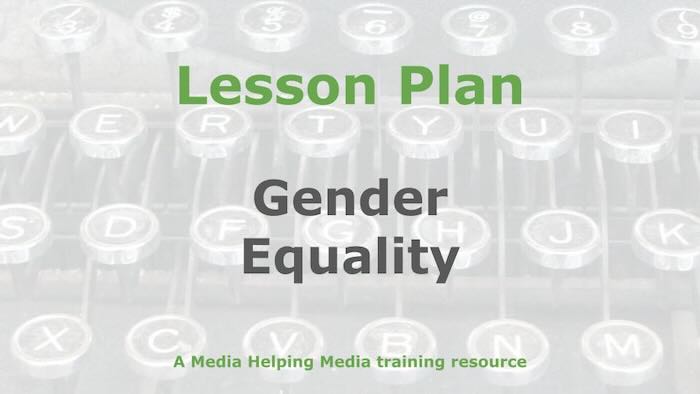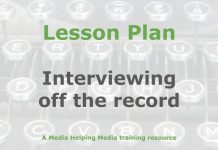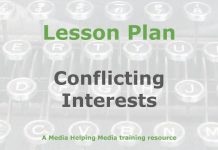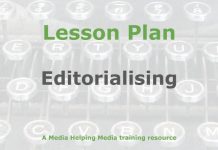 This lesson plan is designed to help journalists understand the need to avoid stereotypes in their news output and understand the importance of gender equality.
This lesson plan is designed to help journalists understand the need to avoid stereotypes in their news output and understand the importance of gender equality.
It’s based on an article ‘Gender equality in the media‘ which we suggest you read before planning the lesson set out below.
Learning objective
Students will critically analyse media content to identify gender stereotypes and evaluate strategies for promoting gender equality. They will apply these strategies to create a media piece that challenges existing stereotypes and supports gender equality.
- Student-facing objective: By the end of this lesson students will be able to spot gender stereotypes in the media and come up with ways to promote gender equality through their own media work.
- Standards: To teach journalism students how they can play an important role in promoting gender equality rather than perpetuating gender stereotypes.
Learning activities
Warm-up
- Begin with a brief discussion on the difference between gender and sex. Ask students to share their understanding of these terms. Clarify that sex refers to biological differences, while gender is socially constructed and fluid.
- Next, present a short media clip or image that includes both male and female characters. Prompt students with: “What do you notice about how men and women are portrayed?” and “What do you wonder about the choices made in this portrayal?”
- Encourage students to share observations and questions with a partner. Conclude by asking a few students to share their insights with the class. Record key points to reference later. This primes students for deeper analysis of gender representation in media.
Direct instruction
- Conceptual understanding: Introduce the concept of gender representation in media. Present statistics on gender disparity in media coverage, such as women making up only a quarter of those seen or heard in news output. Discuss the implications of these statistics on public perception and societal norms. Use real-world examples, like the portrayal of women in STEM fields, to illustrate how media can both challenge and reinforce stereotypes.
- Procedural skills and fluency: Guide students through an analysis of a media piece. Provide a news article or video segment. Ask students to identify the gender of the individuals featured, their roles, and how they are portrayed. Encourage them to note any stereotypes or biases. Facilitate a class discussion on their findings, focusing on how these portrayals align or conflict with the principles of gender equality.
- Application: Challenge students to create a brief media piece (e.g., a news article, blog post, or video script) that promotes gender equality. Provide criteria: equal representation of genders, avoidance of stereotypes, and inclusion of diverse voices. Allow students to work in pairs or small groups. Conclude with a sharing session where students present their work and reflect on the process of consciously promoting gender equality in media.
Guided practice
Think, Pair, Share: Guide students through a structured analysis of a media piece to identify gender stereotypes and biases.
- Think: Present a media clip or article. Ask students to individually note any gender stereotypes or biases they observe.
- Pair: Have students pair up to discuss their observations. Encourage them to compare notes and identify common themes or differences.
- Share: Facilitate a class discussion where pairs share their findings. Highlight key points and connect them to the lesson’s learning objective.
- Reflect: Ask students to reflect on how these stereotypes might influence public perception and societal norms.
- Connect: Encourage students to consider how they can apply these insights to their own media work to promote gender equality.
Independent practice
- Assign students to select a media piece (e.g., article, video, advertisement) and analyse it for gender representation.
- Instruct them to identify the gender of individuals featured, their roles, and any stereotypes or biases present.
- Ask students to write a brief reflection on how the media piece aligns or conflicts with gender equality principles.
- Encourage students to propose one strategy for improving gender representation in the selected media piece.
Circulate to observe and support students as needed.
Assignment
Ask students to answer these questions:
- How can media perpetuate gender stereotypes?
- What is one strategy you can use to promote gender equality in media?
- What’s one question you still have from today’s lesson?
Here are some suggested answers:
- Suggested answer to Question 1: Media can perpetuate gender stereotypes by consistently portraying women in passive roles or as victims, and by not featuring women as experts or leaders.
- Suggested answer to Question 2: One strategy is to ensure equal representation of genders in media content and to avoid using stereotypes in portrayals.
Teacher resources
Differentiation guide
- Advanced learners: Encourage deeper analysis by having students explore the impact of gender representation in media on different cultures. Suggest they research and present findings on how media portrayal of gender varies globally and its societal implications. Challenge them to create a media piece that addresses these cultural differences while promoting gender equality.
- Striving learners: Simplify tasks by providing structured templates for media analysis and creation. Offer examples of gender stereotypes and biases to guide their analysis. Pair them with peers for collaborative work, ensuring they have support in identifying stereotypes and proposing strategies for gender equality. Use visual aids and simplified language to reinforce key concepts.
- Background reading: We recommend you read the article ‘Gender equality in the media‘ before planning this lesson.
Notable definitions
- Gender: Socially constructed roles, behaviours, and attributes that a society considers appropriate for men and women. Unlike sex, gender is fluid and can vary across cultures and time.
- Stereotype: A widely held but oversimplified and fixed idea or image of a particular type of person or thing, often leading to prejudiced attitudes and beliefs.
- Representation: The way in which media portrays particular groups, communities, experiences, ideas, or topics from a particular ideological or value perspective.
Required materials
- Media clips or images featuring both male and female characters
- News articles or video segments for analysis
- Materials for creating media pieces (e.g., paper, pens, computers)
- Access to online resources for research and media creation
- Reflection sheets for independent practice
- Assignment slips for student responses
Lesson summary
- Warm-up
- Direct instruction
- Guided practice
- Independent practice
- Assignment
The free teaching tools at the Khan Academy were used as a basis for converting the original article into a lesson plan.
Related article








